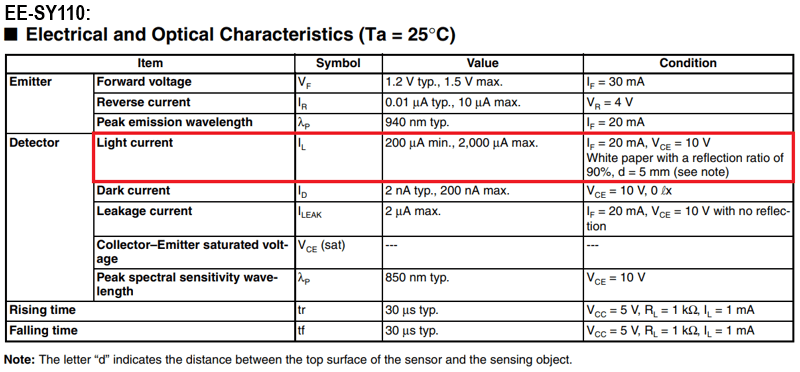Explain cautions when using reflective Photomicrosensors(photointerrupters).
ID: FAQE40014E
update:
Answer
The light current from reflective Photomicrosensors(photointerrupters) is weaker than transmissive Photomicrosensors(photointerrupters). There are various factors such as color, surface conditions of objects, detectable distance, etc. that can affect performance. Considering these factors, please conduct evaluations using the actual device/equipment.
Explanation
Photomicrosensors consist of semi-conductor components, so they have different light current characteristics. Typical Photomicrosensors, EE-SY110 series, have a range of 200 to 2,000 μA of light current distributions (refer to the table below). In order to evaluate electric/optical characteristics of Photomicrosensors, we used a typical white paper with 90% of reflectivity as an object in the evaluation (but such material is rarely used as an object in actual applications). Please refer to the graph below showing characteristics of various materials (“b” is white paper), and select the best threshold values allowable to detect objects with the minimum value of light current and the maximum value of sensor. Furthermore, in order to maintain the stable detectability of Photomicrosensors, pay attention to disturbing factors (LED degradation, deteriorated reflectivity due to loss of colors or dust) that could affect the light current. Reflective Photomicrosensors are susceptible to disturbing light, so prevent any external light from entering into the sensing area of sensor. It is recommended to optimize device/equipment designs. For more information, refer to “Basics of Photomicrosensors: Design and Cautions.”


Quick tips
Photomicrosensors (output: phototransistor) detect objects using S/N ratio (comparing the amount of light received when there is an object (S) or no object (N)). When the ratio between S and N increases, the detectability of sensor develops.
On the other hand, the light distributions of EE-SY110 series are 200 μA(max)/2,000 μA (min), so in order to use EE-SY110, degradation of LED must be considered. This means that it is necessary to optimize device/equipment for detecting objects even when the light current decreased by half. This type can detect objects when there is no disturbing light/background; however, optimization of equipment/devices is necessary, especially for detecting a black symbol on a white paper. If it is difficult to increase the ratio between S and N, use external circuits.
Please refer the following other ideas:
- Customers adjust the load resistance value for each individual object.
- Measure the light current of each sensor and separate them into groups. Apply the appropriate load resistance for each group.
- For low S/N ratio applications, create a special circuit which initially measures the output voltage of the applied sensor with a reference object in the equipment and set the threshold level automatically.
| Product category | Sensors Photomicro Sensors |
|---|---|
| Classification | Usage, Applications |
| Related keywords |
|